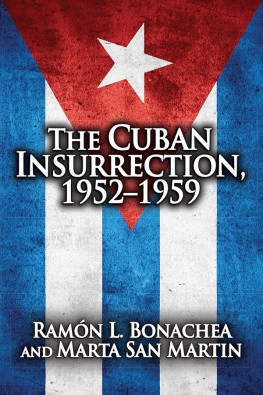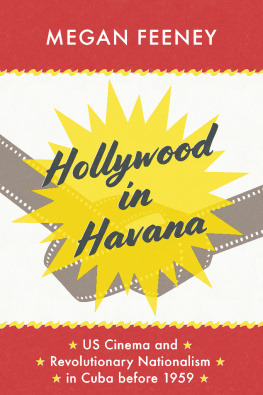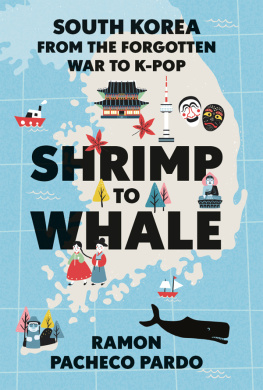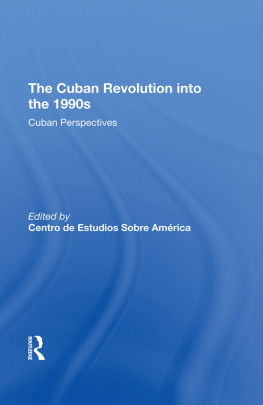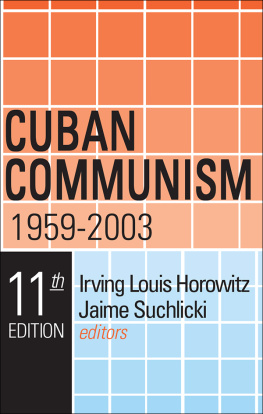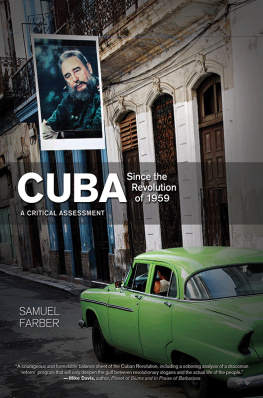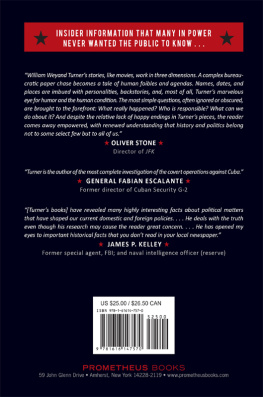First published 1974 by Transaction Publishers
Published 2017 by Routledge
2 Park Square, Milton Park, Abingdon, Oxon OX14 4RN
711 Third Avenue, New York, NY 10017, USA
Routledge is an imprint of the Taylor & Francis Group, an informa business
Copyright 1974 by Taylor & Francis.
All rights reserved. No part of this book may be reprinted or reproduced or utilised in any form or by any electronic, mechanical, or other means, now known or hereafter invented, including photocopying and recording, or in any information storage or retrieval system, without permission in writing from the publishers.
Notice:
Product or corporate names may be trademarks or registered trademarks, and are used only for identification and explanation without intent to infringe.
Library of Congress Catalog Number: 72-94546
ISBN 13: 978-0-87855-576-5 (pbk)
ISBN 13: 978-0-87855-074-6 (hbk)
For several years now, the authors have felt that no meaningful understanding of the Cuban Revolution can be obtained without exhaustive research into the political-military factors that led to the victory of the insurrection. Our interest in the 1952-59 period sprang from intellectual rebelliousness; we wanted to challenge what we felt had become a maze of ill-founded premises about the social, military and political genesis of the Cuban revolutionary process. We believed that a legitimate beginning to any study of this period would require us to unearth the names of men and women whose ideas and actions, oddly fallen into an aura of anonymity, had been central to the nature and direction of the struggle. Thus, this book has been written from the point of view of the Cuban insurrectionists.
Research for this work is based as much as possible on primary sources. Important gaps would have remained had it not been for the enthusiastic cooperation of hundreds of people, many of whom were actors in the struggle. Through the facilities of a community action agency located in the heart of a Cuban exile community, the authors were able to establish fruitful relationships with Cubans from all walks of life. We found that these persons were eager not only to share their part in the events but to supply the authors with letters, documents and names of persons for corroboration of their information. The fact that a good number of the people we interviewed were militants or participants but not leaders of the various struggling sectors adds a satisfactory measure of history from the point of view of the individual insurrectionist, former regular army soldier, rural guard, supporter of Batista, 26 of July member or member of the Directorio Revolucionario (DR).
These data were added to the personal experiences of one of the authors (Ramn L. Bonachea), who was a direct participant in several of the events described, as well as a member of a DR cell. In this capacity, he had the privilege of interviewing most of the leaders of the insurrection while in Cuba, and of visiting the sites of the main eventsSierra Maestra, Sierra Cristal, Escambray, Cienfuegos, Sagua la Grande and others. At the suggestion of Major Ernesto Che Guevara, one of us prepared a series of reports analyzing guerrilla warfare in Cuba in February 1959, which also proved useful in preparing this book.
Additionally, the authors have relied on abundant use of secondary sources, including material that the Cuban revolutionary government has published during the last 15 years. This material complemented the data obtained by the authors through personal interviews and letters from former militants. No small amount of rigorous assessment was needed to separate the obvious from the trivial and hagiography from historical facts.
We owe special thanks to the family of Jos Antonio Echeverra who placed at our disposal the private documents of the DR leader and participated in what amounted to their first public interview. Dora Rosales Westbrook shared many hours reminiscing about the political philosophy of her son. Joe Westbrook, and discussing the participation of many of his compaeros in the formation of the DR. Ricardo (Popi) Corpin was kind enough to review point by point the historical Pact of Mexico between the DR and the 26th of July movement, to which he and Fidel Castro are the only living witnesses. Ricardo Bianchi and Sra. Bianchi shed light on the Autntico cooperation with the DR, the events surrounding the Humboldt 7 episode, as well as on the preparations for the Palace attack and various other actions. Flix A. Murias, Armando Fleites, Adalberto Mora, Julio Fernndez, Roger Gonzlez and other DR members were extremely kind in revealing important sequences to the authors.
Ral Chibs, Mario Llerena and Manuel Urrutia Lle greatly enhanced the sections of the book pertaining to the ideology and formation of the provisional revolutionary government. We were privileged to make special use of Dr. Llerenas candid manuscript without which we would have been unable to reconstruct the internal structure of the Direccin Nacional.
Former members of the 26th of July movement were equally helpful. Of special importance for the authors was their acquaintance with the men and women who fought side by side with Frank Pas. They were not only helpful but extremely patient and kind in answering our queries about Frank, his movement and role during the insurrection. Above all, the authors feel a special gratitude toward Agustn Pas, whose courage, candidness and simplicity gave the authors a measure of what Frank, his brother, must have been like.
Thanks are also due to Carlos Pro Socarrs, Carlos Mrquez Sterling, Eusebio Mujal Barniol, Manuel Antonio de Varona and Antonio (Tony) Santiago for clarifying events in which they participated. Enrique Pizzi de Porras, from the staff of El Tiempo newspaper, availed the authors of the opportunity to examine Fulgencio Batistas answers to some specific questions concerning the last days of December 1958.
For assistance in formulating our analysis of events in the military sector we must express our appreciation to many guerrilla fighters and soldiers of the regular army. Many front-line guerrilla fighters provided a most objective account of the guerrilla campaign and their names are duly recorded in the text. Among the officers of the regular army, we are indebted to General Eulogio Cantillo who broke his long silence to discuss with us his personal role in the insurrection, and allowed us access to his private documents and correspondence. Colonel Nelson Carrasco Artles, active in the Sierra Maestra campaign, wounded in battle and prisoner of the Rebel Army until 1959, was very helpful in sharing articles and letters about the regular army. Colonel Fernando Neugart described to us his experiences as the governments negotiator in special talks with Fidel Castro during the summer offensive of 1958. This was also the first interview granted by the colonel since 1959. Captain Abon Ly spent many hours with the authors describing the battle of Yaguajay as well as giving his own impression of guerrilla leader Major Camilo Cienfuegos. Colonel Merob Sosa was interviewed on his role during the early stages of the Sierra Maestra campaign. He corroborated the legitimacy of military communiques published by the Cuban revolutionary government, and gave his version of the governments preventive measures against the Oriente peasants.


